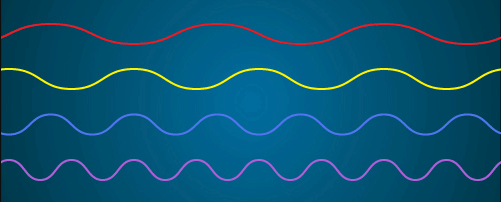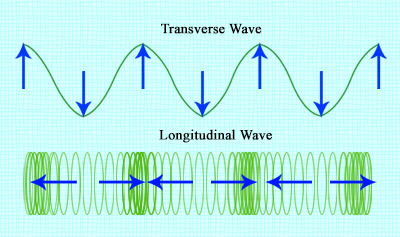Key Concepts
The traveling pattern of motion exhibited by a wave, combining both oscillatory motion and forward motion. Examples of wave motion include the motion of ocean waves, light waves (Fig. 1), sound waves, and waves on a string. The oscillatory motion aspect of a wave has features that are typical of all types of oscillatory motion, such as frequency. The frequency f of a wave is the rate at which the oscillations occur at a fixed location as the wave passes by. The forward motion aspect of a wave has features that are typical of all types of forward motion, such as velocity v. For all types of waves, the velocity of a wave obeys the equation, v = λf, where λ is the wavelength of the wave. The wavelength is the spatial distance between two consecutive peaks of the wave. The velocity of a wave is called the wave velocity, the group velocity, or the signal velocity. The information, energy, and momentum carried by a wave travel at the wave velocity. See also: Energy; Frequency (wave motion); Light; Momentum; Oscillation; Sound; Velocity; Wave (physics)

Waveforms and wavefronts
A wave is an extended object that is spread out through three-dimensional space. The waveform of a wave is the overall spatial shape of the wave in the direction the wave is traveling. In contrast, the wavefronts of a wave are the overall spatial shapes of the wave in the directions that are transverse to the direction the wave is traveling. In simple cases, the waveform and wavefronts of a wave move forward without changing shape. However, when dispersion is present, the waveform changes shape as the wave travels. When a wave interacts with a lens, curved mirror, or similar objects, its wavefronts change shape. See also: Dimension; Dispersion (radiation); Lens (optics); Mirror optics; Space
Types of waves
The specific way in which a wave moves depends on its type. In general, there are four types of waves, listed below.
Mechanical waves are the waving of the bits of mass that make up a material medium. Mechanical waves include sound waves, water waves, seismic waves, and waves on a string. A mechanical wave arises from the way particles of matter push and pull on each other, analogously as a line of falling dominoes. How well a mechanical wave moves through a material depends on the material's density and stiffness. The higher the density of the material, the more it resists the accelerations required of wave motion, and therefore the slower the wave travels in that material. At the same time, the higher the stiffness of a material, the more quickly it snaps back into place after being displaced by a passing wave peak, and therefore the faster the wave travels in that material. Therefore, mechanical waves travel fastest in low-density, high-stiffness materials. For instance, waves traveling along guitar strings move the fastest on thin, tight strings. See also: Acceleration; Density; Matter; Musical instrument
Electromagnetic waves, commonly referred to as light, are the waving of the quantum electromagnetic field. Electromagnetic waves move because of a repetitive feedback cycle between the electric field component and magnetic field component of the wave, as they create each other. Because an electromagnetic wave is fundamentally a waving of a universal quantum field and not a waving of matter, an electromagnetic wave can travel through a vacuum. How fast an electromagnetic wave moves in vacuum is a universal constant called the speed of light c. This speed is the same in all reference frames and in all situations. In contrast, when electromagnetic waves travel through a material, they travel at a speed less than c because the wave electromagnetically couples to the material. See also: Electric field; Electromagnetic field; Electromagnetic radiation; Electromagnetic wave; Electromagnetic wave transmission; Electromagnetism; Magnetism
Quantum matter waves, also called de Broglie waves, are the waving of a quantum field associated with a particle with mass. For instance, an electron consists fundamentally of a wave packet traveling through the quantum electron field. Quantum matter waves move simply because it is the nature of a quantum field to propagate waves. A quantum field is fundamental and is not composed of atoms. If oscillations in a quantum field are created properly, they become a self-sustaining quantum matter wave such as an electron. Because a quantum matter wave represents the wave aspect of a quantum particle with mass, it moves at whatever speed is dictated by the applied forces. This is similar to how the force of a baseball bat determines the speed of the baseball that it strikes. See also: Electron; Force; Mass; Quantum mechanics
Gravitational waves are the waving of spacetime. Spacetime is the background framework of the universe. It becomes significantly warped by the presence of larges masses such as stars and black holes. The oscillating warping of spacetime establishes traveling ripples in spacetime called gravitational waves. Gravitational waves move because of the tendency of warped spacetime to return to a non-warped state. In vacuum, gravitational waves travel at the speed of light. Even the strongest gravitational waves are extremely weak and very difficult to detect. See also: Black hole; Gravitational radiation; Spacetime; Star
Directionality of oscillation in waves
When it comes to directionality, there are four different types of oscillation that waves can have: transverse oscillation, longitudinal oscillation, composite oscillation, and scalar oscillation.
• Transverse waves (Fig. 2) oscillate in the directions transverse to the direction that the wave is traveling. Transverse waves include waves on a string, electromagnetic waves that are freely traveling, gravitational waves, bulk seismic S waves, and Love surface seismic waves. See also: Earthquake; Seismology
• Longitudinal waves (Fig. 2) oscillate in the same direction as the direction that the wave is traveling. Longitudinal waves include sound waves, bulk seismic P waves, and bulk water waves.
• Composite waves are the combination of a transverse oscillation and a longitudinal oscillation, leading to elliptical oscillations. Composite waves include surface water waves, Rayleigh surface seismic waves, and electromagnetic waves that are confined to travel in a waveguide or along a surface.
• Scalar oscillation waves fluctuate only in magnitude and not in a certain direction. Scalar oscillation waves include quantum matter waves.






